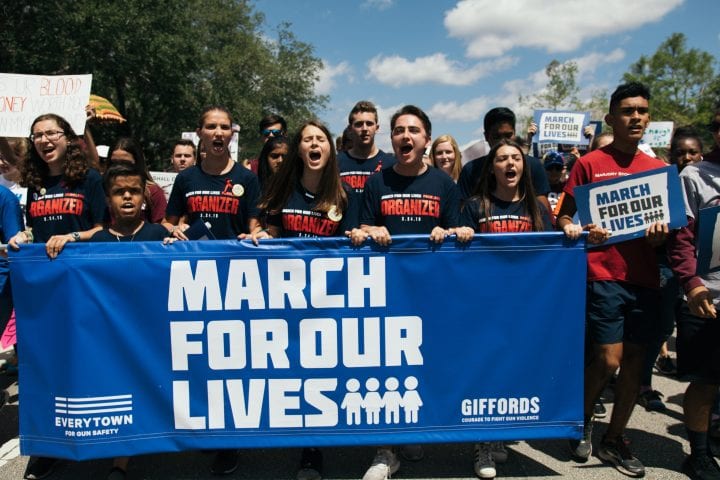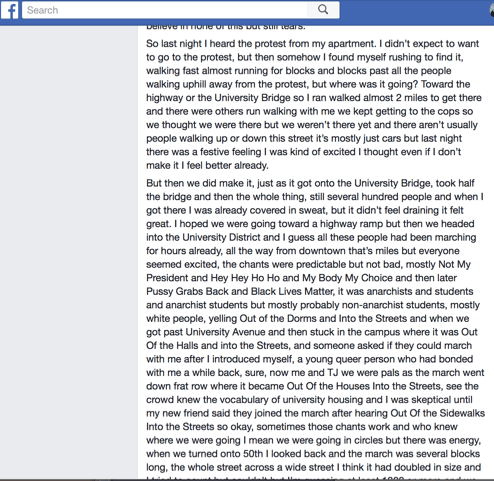
As All The Clocks Turn 10: Students write about the moment of the walkout
March 30, 2018
By Corinne Manning, WITS Writer-in-Residence
I got to work with the students the day after the March for Our Lives School walkout. It was exciting to see news of Roosevelt High School on Twitter, and I went into class wondering what the students would need most.
I wanted to provide them an opportunity to write about it—regardless of where they were at 10 am—choosing to walk out or choosing not to; I wanted to show them writing from a protest, and I wanted them to connect with their senses.
But when I walked into first period, I was greeted by a group of 30 deeply shut-down humans. They didn’t want to talk about the day before. They were tired of it. A numbness carried through the room, and a general lack of participation. When I asked them to practice synesthesia with a piece of paper—what does the sound of ripping paper taste like, what color is the feeling of paper against your cheek—the majority of students complained: it tastes like paper, it feels like paper.
I walked out of the room realizing I hadn’t offered them something crucial: they needed room for their emotions, permission to not know what they were, and the opportunity to try to feel them.
Mattilda Bernstein Sycamore was my mentor text, and this writer, activist, and critic was the perfect example to have with me that day because she steps into a moment as if it’s new—though none of it is ever new. Her work comes from a place of vulnerability that was fiercely relearned and reclaimed.
The writing was from a Facebook post after the November 2016 election:

I asked students about sensory detail: what were the descriptions where you could see/feel/smell what Mattilda was experiencing? It’s powerful to read someone who can be critical and have emotions at the same time. It’s a criticism that’s felt.
“I know I don’t always know what I’m feeling in the moment. Any of you feel that way?” I asked 3rd period. I felt the energy of the room come forward; a number of them nodded or raised their hands.
I asked them what were some of the feelings they had on March 14th at 10 am.
Empowered, a student said. I wrote it on the board.
“What was the specific moment where you felt this in your body? What was happening?”
The student said it was when they were walking by a group of elementary school kids who were holding signs along the side of the march. The little kids cheering. They felt that energy in their body.
“What did other people feel?” I asked.
Angry, a student said.
“Where was the specific moment you felt this in your body?”
For this student, it was when the mayor was telling them that the youth would be the ones who would change things, and in response, the student felt a “buzzing” in their body: it’s the adults who currently create legislative change. “We need this changed right now.”
Some students are conflicted because they need to take a test. They need to get good grades but they want to be out there.
It’s a political act, I think, scheduling a test that day.
A student says they felt relaxed because the teachers weren’t teaching. Students talk about prioritizing school in a way that surprises me. I write that on the board and wonder if I should introduce the idea of feeling numb but am not sure if I can support anyone through that, not when I’m only there for an hour.
I invite them to do a process by Linda Barry called “Go Inside a Memory.” Students draw a big X on a piece of loose leaf so there are four triangles. I ask a series of questions and tell them to put the answer in whichever triangle they think it belongs. This is to help get them thinking more organically, less linearly. It helps produce a kind of trance that gets us back inside a moment:
Where is the light coming from?
What kind of light is it?
Where are you?
What is the temperature?
Who else is with you?
What are they doing?
If you look to the right what do you see?
If you look to the left, what’s there?
Why are you there?
“I tell myself it’s because of soccer but are there more reasons?” a student writes of staying in the classroom, and feeling physical pain about not being outside but not being able to get himself to walk out. He looks around at the other students: “I try to notice if there’s guilt on their faces, but I see nothing.”
“The kids, who are the affected ones, are silenced,” one student writes.
“I am a participant. Blending in with the crowd. Seeing a light shining from others. The feeling is flowing throughout my body. An unknown feeling. It scares me but excites me at the same time. It fills me up,” another writes.
John Berger, in his essay “The Nature of Mass Demonstration,” writes that marches are a kind of dress rehearsal for the revolution. “The more people there are there, the more forcibly they represent to each other and to themselves those who are absent. In this way a mass demonstration simultaneously extends and gives body to an abstraction.”
They write about adults seeing their real rage as sentimental; about some teens seeing their own involvement as sentimental. I ask them questions on these pieces: “What was it like to play in the game that night? what is your relationship to the test being scheduled on that day? what is your breathing like when you are conflicted?”
The current teacher of the year, Sydney Chaffee, discusses the importance of teaching social justice throughout school curriculum: “Teachers don’t just teach subjects, they teach people. When our students walk into our classrooms they bring their identities with them. Everything they experience in our room is bound up in historical context. So if we insist education happens in a vacuum, we do our students a disservice. We teach them that education doesn’t really matter because it’s not relevant to what’s happening all around them.”
When I walked into first period on March 15th, I entered with what I had seen in the media: Roosevelt High School Marches to UW! Unity! Empowerment! But that was only part of the story. The real story was what happened in the classroom: a tentativeness and a conflict; the aftermath of what it actually meant for them to walk out or not that day, for their emotions before during and after. If students are going to participate in the dress rehearsal for the revolution, they need the emotional tools, support, and context to prepare them for (hopefully) the actual performance.
 Corinne Manning received her MFA from UNC Wilmington. Her fiction and nonfiction have appeared in Story Quarterly, Vol 1 Brooklyn, Arts & Letters, Drunken Boat, The Oxford American and The Nervous Breakdown. Her story “Slow Steady Eruption” was published as a chapbook by Alice Blue Books in 2014. She’s received grants and fellowships from Artist Trust, Seattle Office of Arts & Culture and was the Hub City Writer’s Project Writer-in-Residence in 2010/2011. She co-coordinates The Furnace Reading Series, a long form prose reading series in Seattle.
Corinne Manning received her MFA from UNC Wilmington. Her fiction and nonfiction have appeared in Story Quarterly, Vol 1 Brooklyn, Arts & Letters, Drunken Boat, The Oxford American and The Nervous Breakdown. Her story “Slow Steady Eruption” was published as a chapbook by Alice Blue Books in 2014. She’s received grants and fellowships from Artist Trust, Seattle Office of Arts & Culture and was the Hub City Writer’s Project Writer-in-Residence in 2010/2011. She co-coordinates The Furnace Reading Series, a long form prose reading series in Seattle.